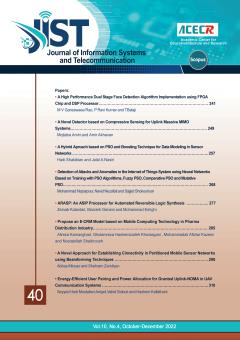-
-
List of Articles
-
Open Access Article
1 - A High Performance Dual Stage Face Detection Algorithm Implementation using FPGA Chip and DSP Processor
M V Ganeswara Rao P Ravi Kumar T Balaji -
Open Access Article
2 - A Novel Detector based on Compressive Sensing for Uplink Massive MIMO Systems
Mojtaba Amiri Amir Akhavan -
Open Access Article
3 - A Hybrid Approach based on PSO and Boosting Technique for Data Modeling in Sensor Networks
hadi shakibian Jalaledin Nasiri -
Open Access Article
4 - Detection of Attacks and Anomalies in the Internet of Things System using Neural Networks Based on Training with PSO Algorithms, Fuzzy PSO, Comparative PSO and Mutative PSO
Mohammad Nazarpour navid nezafati Sajjad Shokouhyar -
Open Access Article
5 - ARASP: An ASIP Processor for Automated Reversible Logic Synthesis
Zeinab Kalantari Marzieh Gerami Mohammad eshghi -
Open Access Article
6 - Propose an E-CRM Model based on Mobile Computing Technology in Pharma Distribution Industry
Alireza Kamanghad Gholamreza Hashemzade Mohammadali Afshar kazemi Nosratollah Shadnoosh -
Open Access Article
7 - A Novel Approach for Establishing Connectivity in Partitioned Mobile Sensor Networks using Beamforming Techniques
Abbas Mirzaei Shahram Zandian -
Open Access Article
8 - Energy-Efficient User Pairing and Power Allocation for Granted Uplink-NOMA in UAV Communication Systems
Seyed Hadi Mostafavi-Amjad Vahid Solouk Hashem Kalbkhani
-
The rights to this website are owned by the Raimag Press Management System.
Copyright © 2017-2025







